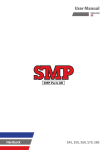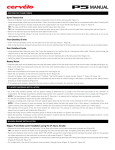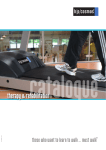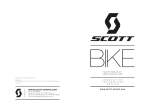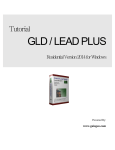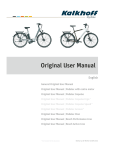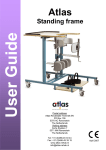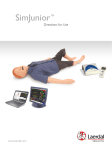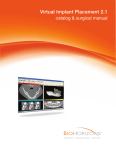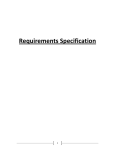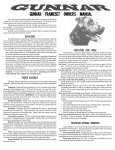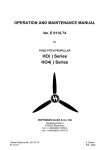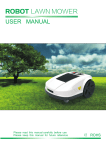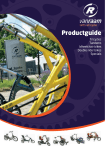Download Operation, Maintenance, Tips and Warranty
Transcript
Operation, Maintenance, Tips and Warranty In order to know the value of your new bike and its functionality, please read this manual carefully before you ride for the first time and keep it safe for entering service details and for later reference. Please follow the operation and maintenance instructions of equipment manufacturers attached to this manual. This manual is available for download along with more tips, images and videos at www.maxx.de/en/facts under "Operation and Maintenance". Table of Contents A. Operation Manual Page 1. Before the first ride 1. Important information on traffic and operation safety B. C. D. 3 .1 Public traffic safety 3 .2 Structural changes 3 .3 Trailer operation 3 .4 Maximum load, Tips for large and heavy riders 3 2. Registration, handover protocol, ownership pass 3. Commissioning and personal settings 4 .1 "Out of the carton" final - pedals and cockpit 4 .2 Setting the saddle position 4-5 .3 Setting of ideal seating position - Cockpit - handlebar/stem 5 .4 Setting the suspension devices (optional) 5 .5 Lighting with hub dynamo (optional) 5 .6 Braking with disc break (optional) 5-6 2. The first ride 7 3. Before every ride 7 4. Transportation 7-8 Maintenance 1. Maintenance – Checklist 8-12 2. Safety components 12 Guarantee of mobility 13 1. Warranty and manufacturer's guarantee 13-14 2. Crash replacement 14 3. Worldwide spare parts supply 14 Contact / About 14 2 Version dated Nov 30.2015 A. User instructions 1. Before the first ride .1. Important information on traffic and operation safety .1.1. Public traffic safety Please note that for joining public traffic, the bike should be equipped with equipment suitable for road traffic and in accordance with the laws of your country, in Germany the ‘StVZO’. This equipment is available on request only and against an additional upcharge. For your own safety, please consult a specialist or us in this regard. You will be responsible for the rideable condition of the bike on public roads in accordance with the laws of the country you are going to ride this bike. According to German ‘StVZO’, the following equipment is required on public roads. Bell (not a bad choice for any other bikes as well!) Lighting such as dynamo, front / tail light, Battery-powered front and tail lights. Front / tail reflectors, pedal cat's eyes, reflectors or reflector strips with a "~" sign. .1.2. Structural changes in the equipment supplied ex factory The MAXX Configuration System enables you to get a customized bike. Note: You will endanger yourself and lose the legal warranty and our additional manufacturer's warranty, if you carry out modifications on the original specification and design of your bike without our prior approval. .1.3. Trailer operation If using a trailer, please note: The coupling should never be attached to the seatpost, but on the rear axle or frame only. MAXX recommends Weber couplings. Note: MAXX full suspension bikes are not permitted using a trailer. .1.4. Maximum load, Tips for heavy and large riders The permissible total load of the delivered bike is determined for your configuration according to your personal weight you provided us. Note: If rider weight exceeds the specified weight, the bike may no longer be safe under certain conditions and the guarantee and our additional manufacturer's warranty will become void. .2. Registration, handover protocol, ownership pass On account of strict product liability laws and as a prerequisite for our comprehensive warranty services, every bike needs to be registered online at http://www.maxx.de/en/facts/registrierung.php. Your dealer will do this for you or MAXX on dispatch or when you pick the bike up in our factory. As confirmation of the registration with owner pass, you will receive a copy in pdf format via email. 3 Version dated Nov 30.2015 .3. Commissioning and personal settings Your MAXX Bike has been delivered in a safe full size carton package. The pedals and additional accessories as well as this manual and other equipment manufacturer’s manual assembled on your bike come in a separate accessories carton. Note: Please keep the large carton for convenience in future transportation due to moving or travelling, or if the bike needs to be sent for servicing. .1 "Out of the carton" final assembly - pedals and cockpit Pedals: Keep in mind the different markings of the thread directions on the pedal's axle: L = left pedal (left thread); R= right pedal (right thread) – when facing the direction of travel. Now place the pedal thread (check correct side!) on the pre-lubricated crank thread and turn it around with fingers as far as it will go. Now tighten it with a 15th fork wrench or Allen wrench with hand (approx. 20 Nms). Click pedals should be set to "light release" before the first trial ride (see the manual for click pedals). Cockpit: To fit the complete bike into the carton for transportation, the cockpit with stem, handlebar, shifters and levers is turned at 90°. Fix the front wheel between your knees and pull the cockpit back into the correct position. Now tighten the stem with its two rear Allen bolts to the fork steerer. The headset play is set properly at our factory. If you need to readjust it, please follow the instructions in the ‘Maintenance Section pp. 9-13 Headset play’. Note: For more tips, please go to "Use and Maintenance" at www.maxx.de/en/facts. .2 Setting the saddle position The seatpost can be moved up and down in the seattube of the frame. It is attached by tightening the Allen key or by closing the Quick Release eccentric clamp lever. The pretension of the lever can be adjusted by turning the small wheel on the opposite side of the lever. The seatpost should only be fastened enough to ensure that the saddle does not turn in the seat tube with normal force. Please follow the ‘Max’ marking on the bottom of the post that limits the maximum pullout from the seat tube. Suspension or telescopic seatposts should remain 120 mm in the seattube as a minimum to prevent risk of breakage and injury. For setting the correct saddle height, there are two methods: ‘Heel method’ - You place the heel of your shoe on the pedal and set the saddle height so your leg is straight at the bottom of the pedal cycle with the pelvis remaining in a horizontal position. ‘109% method’ – just check the recommended saddle height in your basic configuration. Opening the bolts of the seatposts saddle–clamp slightly will enable you to adjust the correct saddle position: 4 Version dated Nov 30.2015 Saddle angle: It should be as horizontal as possible. Note: In the contact area there are sensitive nerves and veins; if there is any pain or numbness, please lower the saddle height or saddle nose - or worst case: replace it by a wider or softer saddle. Distance to handlebar: The simplest method for a correct saddle fore-aft position is to hang a plumb line from your tibial tuberosity (the bony bump below your kneecap). This should pass straight through the pedal spindle when the crank arm is at 3 o'clock. .3 Setting the ideal seating position - Cockpit - handlebar/stem The more sporty the desired position, the more bent is the torso. You should be able to reach the handlebar with slightly bent arms. Too cramped a sitting posture can cause numbness in the arms and also pain in the neck. If required, a shorter or longer stem or a more or less elevated handlebar should be selected. .4 Setting the suspension devices - front and rear suspension (optional) Every suspended frame should be adjusted individually to its owner. Please follow the user and setting instructions of the rear shock or suspension fork maker attached to this bike. Suspension fork and rear shock build a dynamic unit and must be adjusted according to each other. A special high pressure pump is required for adjustment – optionally available at MAXX or in every bike shop. 5 Lighting system with hub dynamo (optional) You have configured your bike with a modern automatic lighting system with the current source, the hub dynamo, in the front hub. The light switch has the controls: On "T": light on; On "0": light off; On "S": automatic light - using a sensor - the light system automatically switches on at twilight. Note: Before disassembly of the front wheel, pull out the cable plug on the right hub side, otherwise the contacts will tear off. While reassembling the front wheel, plug in again and check your lights. .6 Braking with the disc brake (optional) In order to be able to enjoy the full braking power and avoid noises and vibrations from the discs, the brake pads and discs should be completely ‘braked-in’ on the first rides. Note: Improper braking-in can cause irreparable damages to the brake pads and discs, which will demand expensive replacements, since none of the brake manufacturers will cover this in their warranty. This method is also applicable after brake pads or discs have been is replaced. The purpose of braking-in (as in cars and motorbikes) is to coat a uniform layer of brake padding material on the new disc, which creates the desired friction on the disc surface. For proper braking-in, discs and pads need to first be brought to the right operating temperature by soft braking to enable material transfer and then to completely cool it. 5 Version dated Nov 30.2015 Note: Decelerate only up to walking speed, do not stop! During this process, the wheel should never be brought to a stand still, since this would cause a partially thicker coating of brake padding material, which will permit vibrations or squeaking. The right braking-in of a disc brake Select a trail or a road that allows for medium speed. Remain on the saddle. On walking speed, brake about 20 times on approx. 30 km/h. Accelerate to higher speed and repeat the process approximately 10 more times. Allow the brake to cool down completely - without using water - before the next ride. Correct braking with a disc brake It is normal in wet conditions for the braking to make some sounds. Do not constantly 'grind' the brakes in long rides. Rather, use front and brake alternately to help them to cool down. The front wheel can have considerably more brake output (approx. 70%) than the rear wheel (approx. 30%). Learn to brake safely with both brakes for off road biking. Lower air pressure in front wheel increases the grip. The wear and tear depends heavily on your brake behaviour, weather conditions and the ‘downmeters’ performed. Notorious 'rear wheel brakers' will have an extremely high rear wheel pad wearing. Regularly check the pad strength remaining and replace the pad on time with manufacturer instructions. Only use the original brake pads by the brake manufacturer, otherwise you will put yourself in danger and also lose the warranty claim. Please follow the attached operation manual of your braking system. 2. The first ride Take a trial ride alongside the public road and on known terrain in order to get familiar with the technique and coordination of all operating elements. Ride with care and attention to familiarise yourself with the new bike and its seating, steering, gear operation and braking properties. Braking: Follow the provided operating and usage instruction of the brake manufacturer and our braking-in instructions mentioned above. In modern brake systems, the braking performance is high and needs familiarisation. Be extra careful on soft or wet grounds. Never brake with one hand on the handlebar. Check the levers pressure point. Observe which brake lever operates which brake and which wheel decelerates. Shifting: Shift the gears only while pedalling. 3. Before every ride For your own safety, make it a habit to submit your bike a routine check. 6 Version dated Nov 30.2015 wheel-locking systems: quick releases or through axles all fixed? Wheels: both wheels turning well? All spokes firm? Tires: Air pressure ok? Valves in vertical position? Headset: Push the bike with braked front wheel and back and check with your hand on the upper headset section if it is without play? Cockpit: Clamp the front wheel between the knees and ensure that handlebar setting is correct and does not twist. Braking: Stand by the bike and simulate with both brakes a powerful braking manoeuvre. In case of rim brakes, check the correct middle position of the brake pads on the rim flank, especially if the front wheel was dismounted for transportation. Winter riders, attention: Humidity in brake and gear housings can freeze and block the wires when it is very cold. (see Maintenance page 4-6) 4. Transportation ... in the car To transport your bike in the car, it may become necessary to take off the seatpost/saddle unit and/or one or both wheels. The seatpost/saddle unit can be easily pulled out from the seattube after lifting the quick release lever of the seatpost clamp. For removing the wheels, the housing carrying brake cables must first be removed from the horizontal bracket above the tire. For optionally configured hydraulic braking systems please follow the attached manufacturer's recommendations. Then open hub quick release lever and remove front wheel. To dismount the rear wheel, shift the chain on the smallest cassette sprocket and shift back to the largest sprocket for transporting in order to protect the Rear Derailleur against damages. Note: To re-assemble the wheels, place the hub axle behind the safety nose of the fork dropout. If your bike has traditional rim brakes, make sure that the brake shoes of the rim brakes do not contact the tire bead. And don't forget: Check your brakes before you ride! If your wheels have through-axle systems, follow the manufacturer's instructions attached. ... on the car If you are carrying your bike on a roof or on a rear carrier, do not remove the seatpost/saddle unit without first completely sealing the inner seattube against spray water and dirt. Keep in mind that in external transport especially in roof transport, the bike will be exposed to stones, insects, moisture or corrosive, salty ocean air. Furthermore, the carrier and bike should be protected against theft. ... on air Handover your bike to the airline only once you have safely packed it in a bike case or in the bike carton provided to you by MAXX along with the purchase. All exposed parts such 7 Version dated Nov 30.2015 as pedals, cockpit components and Rear Derailleur should be particularly protected or dismounted. In the rear wheel, shift the chain to the largest cassette sprocket. Turn the entire cockpit unit by 90° and fasten it. Do not sharp bend the shifting and braking housings. Frame tubes can be well protected with foam-insulating tube from a hardware store. Always have in mind that you may have to unpack your bike unexpectedly and with time restraint for a security or customs inspection. B. MAINTENANCE 1. Maintenance - Checklist Check your bike after every ride. Often, there are small issues you can fix yourself. However, if in doubt, always consult an expert. Only he has the skill, tools and spare parts to make your bike safe and functional. Maintenance and care instructions for all components have been attached with this bike and are also available at every website of the particular component manufacturer. Protection against corrosion and weather conditions: All components have been made weather resistant for normal use with the help of a special surface protection coating like anodisation or powdercoating. If this coating is damaged, the weather resistance of the component is not guaranteed anymore and it will need to be replaced. Keep in mind that salt water in coastal areas (holidays at sea) or de-icing in winter considerably compromise the service life. The same is applicable for unprotected storage in open or humid (cellar) rooms. For better protection, frames and components can be coated with protective wax after cleaning. Note: Brake pads, rim flanks and discs must stay always free of wax, grease and oil. Derailleur Drive transmission: This well-proven traditional transmission – with chain, cassette, chainrings, front and rear derailleur - is a sensitive system. It must kept clean and well cared with special materials by specialist manufacturers and checked in regular intervals by an expert for wearing. Only a properly cleaned and maintained chaindrive ensures perfect shifting functions and maximum run time for the chain and all connected components. Rear Derailleur: Protect this most sensitive gear shifting component especially from undue violence. Place the bike always on the opposite side of the Rear Derailleur. MAXX frames have exchangeable dropouts to protect the frame itself against further damage. Greater impacts on the Rear Derailleur will be directed to the exchangeable dropout and might cause its planned bending or breakage. Note: Always keep this sparepart in the reach of your accompanying bike equipment. 8 Version dated Nov 30.2015 Fine adjustments: Let an expert show you how you can yourself make the fine adjustments to gear shifting system. Note: By turning the adjuster barrels of the gear shifters, you can also influence the tension of the shifting cable even during a ride. Often, less than a complete turn is enough to fix a ‘noisy’ chaindrive. Internal hub and gear drive: These systems require much less maintenance than a traditional Rear Derailleur drivetrain. For more information please see the manufacturer's manuals attached. The chain should be serviced with materials by a specialised manufacturer. Sprocket and chainring should be regularly cleaned. If your bike has a belt drive, it will require special handling – please take all details from the attached manual from the manufacturer. Correct setting of chain or belt tension: This needs some skill. In case of doubt, request an expert to do it. MAXX has two different systems: 1) Chain tension through sliding, adjustable drop-outs: Loosen all four allen bolts (5mm allen key) on the outside of the dropout. Now move the two sliding dropouts on the left and right inside of the frame’s dropout counterpart by turning the two adjusting bolts (4mm allen key) on the back side of the dropouts into the desired direction - tensing or loosening. Positioning the rear wheel: While tensing, it is important to ensure that the rear wheel is sitting centered in the frame by tightening both adjusting bolts equally. A tilted rear wheel can be corrected by adjusting one of the two bolts. After finalizing the correct rear wheel position, the four allen bolts should be tightened again with 10 Nm. Make sure that the two adjusting bolts are positioned right up to their attachment point. 2) Chain tension through excentric bottom bracket: The excenter wedge can be loosened by opening the allen bolt (5mm allen key) counter-clockwise on the left side in the direction of ride - if blocked, with a short metallic hit on the allen head. Now the buttom bracket can be turned in the desired direction – tensing or loosening. Finally fix the bolt with a torque of 10-12 Nm. Optimum chain tension has been achieved when the chain can be moved up and down from its tightest point at least up to its measured height. Note: While tensing the chain, keep in mind that the brake and shifting housings will move along with the sliding dropout. Therefore it is helpful to loosen the clamps of the housings at the chainstay. The shifting and brake housings along the frame demand special care. The entire gear range of modern shifting systems is indexed and adjusted to maximum accuracy. Hard to operate or blocked brakes are sources of extreme danger for the biker. Be sure all cables move easily in their housings. Avoid anything that could make the movement difficult like dirt, dust, spray water (rust and frosting in winter), extreme bends, cracks or breaks in the housings. If your brakes are hydraulic, make sure the hydraulic liquid containing hoses are not broken or damaged anywhere. If liquid is seeping on hoses or on their connections, take the bike immediately to a specialist mechanic. 9 Version dated Nov 30.2015 Cleaning: Avoid high-pressure cleaning. High-pressure stream of water and extremely high air pressure, if used incorrectly, can damage the basic lubrication in bearings and chains, seals, decals and even the powdercoated surface. In addition, the water can get inside the frame's interior, causing corrosion and therefore compromise safety. For removing the dirt, a garden hose with gentle stream and a car wash brush are quick adequate. Note: Avoid oil-containing waste water will reach sewage system or ground. Split seat stay: If your frame has a split seat stay, make sure the bolts are all tightened properly. Frame: After cleaning the surfaces, check for cracks, warpage, paint cracks, especially after a crash. Show the damaged parts to an expert. For avoiding corrosion, damage to paint should be sealed by an expert without delay. MAXX offers a renovation service (Frame Clinic) for this purpose. Liquid Acrylic paint sticks are available for all colours at your local paint shops. Suspension elements (optional): Make sure after or before every ride that your suspension rear triangle and all suspension elements are without play and all bolts are fixed. Play in the bearing and loose joints can quickly lead to irreparable damages to the bearings and their seats. The machine bearings are lubricated for long duration and are maintenance-free; but high-pressure cleaning or solvents ruin them quickly. Follow the provided operating and maintenance instructions by the suspension element manufacturer. Fork: A compressed or bent fork needs to be replaced immediately. Suspension forks need to be operated and serviced according to the provided operating and maintenance instructions by the suspension fork manufacturer and may only be repaired by authorised personals. Keep in mind that all screws and bolts need to be properly tightened. Use the torque mentioned in the provided operating instructions by the component manufacturer if not mentioned on the component itself. Headset: Check your bike for play in the headset by listening for vibration and by holding the front brake and moving the bike forward and back. Loosen the two bolts that clamp your stem onto your steerer tube using an Allen wrench. Tighten your stem cap using an Allen wrench. It doesn't have to be incredibly tight, just snug. Check your bike to see if the play in the headset is gone. Align your stem with the front tire so your handlebars are straight and then re-tighten the bolts on your stem. Note: This central 'top cap' screw is only for setting the headset play. It is not for fixing the stem on the steerer tube. Handlebar and stem: The stem must be tightened and clamped with the specified torque on the fork’s steerer tube and on the handlebar. Check for damages after a crash! 10 Version dated Nov 30.2015 Seatpost: During rides in winter and rain, spray the inner part of the seat tube with spray wax to protect it from corrosion. The seatpost should only be pulled out from the seattube up to the point indicated as Max. Bottom brackets must be able to turn slightly, but must not have any play. Humidity and water destroy the bottom bracket bearings. Therefore, be careful while cleaning, riding in rain, crossing waterways or during transportation on a car in rain. Pedals: The modern pedal bearings don't need to be lubricated. For correct assembly, refer to 1.4.1 or www.maxx.de/facts "Operation and maintenance". Brakes: Check hydraulic brake hoses, cables and housings for damages or cuts. The brake pads of a rim brake must be at the middle of the rim flank in every brake lever position. Too high a setting will damage the tires, too low a setting will make the brake shoes touch the spokes. Replace worn brake pads in time. Sand the glazed brake pads with approx. 150 points emery paper. Clean the rim flanks with cleaner's solvent (avoid contact with the tire!). Follow the provided operation and maintenance instructions of the brake manufacturer if your bike has a special braking system. Wheels: The hub axles must be tightened by closing the excentric quick release lever at 90° - it should be positioned on the frame and fork in such a way that unintentional opening is prevented. Never try to tighten the hub axle by turning the nut of the opposite side of the quick release lever. The front nose of the forks axle bead has an important safety function, especially in disc brakes. If your hub has special locking techniques such as through axles, motor drive hubs or internal gear hub with torque guards, follow the provided operation manual of the manufacturer. All spokes should have the same tension. Loose spokes will cause axial and radial runouts in the wheel. Particularly in case of a collision, check rims for runout Permitted play is approx.1 mm. See an expert for re-truing the wheel. The brake pad surfaces - rim flanks or brake discs - must always be clean, free of grease oil, and cracks, smooth, fissures or warping. Rim connecting joints should not indicate any noticeable misalignment or edges. The rim flanks are a part of the brake system if rim brakes are being used. Therefore, they will be subject to a certain wear and tear. They will have to be replaced when the flanks bend concave inwards and the indicated wear limit is reached. Fixed bolts, reeling and wear level of the brake discs need to be checked regularly by an expert. Tires: Tires must always have the specified air pressure. The minimum should be selected in such a way that under full load, the tire never cuts through rim flange and tube. Refer to manufacturer's instructions on the tire flank to find out the maximum permissible pressure. Note: Do not use any installing paste when changing tire. Inspect the tire for cracks, cuts or other damages. Damaged tires must be replaced immediately and the reasons must be 11 Version dated Nov 30.2015 identified and removed by an expert. Note: When buying a new tire, keep in mind that the tire width and air pressure correspond with the rims and tubes. Consult an expert or manufacturer's website for related information. Tubes: Always check, especially in case of rim brakes, if both valves are vertical to the rim. The use of the valve nut is not recommended, since the valve's sideways settings cannot be discovered immediately. The valve in the rim hole acts like an anchor while braking and cause a 'wandering' of the tube in the tire and will finally tear the tube in the valve area. 2. Safety components The modern bike is a sophisticated sports and leisure vehicle with a delicate balance achieved between highest operation safety and user-friendliness in accordance with the latest technologies available. A number of components are subject to wear. Experiences have shown that depending on the operation duration and operation intensity, there may be weakening and damages that not visible to the eye. Therefore, we recommend regular, minimum annual service and, if required, replacement of handlebars, stem, rims by a specialist workshop. Note: After a crash or similar considerable impact, the bike must be inspected with utmost care by a specialist - particularly concerning fork, wheels, frame, handlebar and stem. If one of the components shows only a slight sign of structural damage, it should be replaced to ensure the rider's safety. C. GUARANTEE OF MOBILITY MAXX Bikes are premium products - robust and enduring. We will be by your side even years after your purchase. This is evident in our offers of a comprehensive world-wide spare parts service and an extended manufacturer's warranty besides a fair crash replacement regulation. 1. Legal guarantee and extended manufacturer’s warranty a) 10-year warranty on MAXX products Subject to the following limitations, terms and conditions, MAXX warrants from the date of the original purchase for a total of 10 years to the original owner of this bike that this bike when new is free of defective materials and workmanship on all privately used MAXX products, indicated and MAXX branded, especially on the frame. Up to 5 years from the date of the original purchase, we provide a 100% warranty. After the 5 years for up to and including 10 years from the date of the original purchase, we will charge a usage part fee of 50% of the replacement component's retail price at the time of the damage. MAXX is free to replace or repair the damaged component against the same or same-value product or 12 Version dated Nov 30.2015 suitable successor. Subsequent improvement works are possible. The prerequisite for this comprehensive warranty is the official registration of the bike or the frame and the service log proof of an annual service by a specialist workshop indicated at the back of this manual. The warranty does not include any further components assembled and no additional labour and freight costs. If the date of official registration is different from the date of delivery by MAXX to the shop by more than one month, the date of delivery to the shop will be valid. The German statutory guarantee of 24 month is applicable for wear parts and components that are considered to be highly safety relevant and subject for permanent care, investigation or early replacement by a specialist such as handlebar, stem, rim, tire - mentioned in the MAXX usage instructions - and in all points that have not been individually discussed here. b) 24-month statutory guarantee for components by other brand manufacturers The statutory guarantee regulations of Germany are applicable for components of other brand manufacturers. Most manufacturers offer an extended manufacturer's warranty that MAXX forwards to the customer without acceptance of a statutory duty. If the bike has not directly been purchased at MAXX, the warranty management of these components will be between the dealer and the responsible service station of the brand manufacturer without any involvement by MAXX. The guarantee and manufacturer's warranty will become void without official registration at MAXX within 1 month of receipt without proof of a regular servicing by a specialist workshop due to improper use and non-adherence to this operation, care and maintenance manual handed over and acknowledged during purchase. due to modification of the original specification of the bike, e.g. subsequent installation of components that have not been approved by MAXX. for wear parts such as chain, cassette, chainring, brake disc and pads, rim flank along with rim brake, tire, tube, brake hose, brake and shifting cable incl. housing. in case of change in ownership in case of damages to components due to crashes, falls, accidents or transport damages. due to force de majeur or events that are not the responsibility of MAXX in case of faults resulting from subsequent damages originating from initial damage that is not immediately appraised and repaired or replaced by MAXX or another specialist workshop. Based on its know-how, the specialist must decide on further action, and, if applicable, refuse further use of bike or component due to safety reasons. 13 Version dated Nov 30.2015 2. Crash replacement MAXX supports its products even for damages due to crashes or faulty usage that do not fall under warranty. We offer convenient replacement prices for all privately used MAXX products proved and branded by the MAXX logo. MAXX guarantees every registered customer for a duration of 10 years, a crash replacement discount of 50% on the current sales price against free sending of the defective component. We also provide convenient replacement prices for other brand products such as wheels, forks etc. 3. Spare part supply – world wide MAXX guarantees you a worldwide spare parts supply even to the farthest corners of the globe at commercially available prices and express delivery surcharges within 72 hours. The delivery address needs to be an official postal address. D. CONTACT / ABOUT MAXX Bikes & Components GmbH Theodor-Gietl- Str. 1 D - 83026 Rosenheim Tel: +49 8031 2605-0 [email protected] Traunstein HRA 8989 CEO: Uwe Matthies 14 Version dated Nov 30.2015














